Financial Planning Report: Analyzing Personal Wealth Management Data
VerifiedAdded on 2023/06/07
|8
|1856
|388
Report
AI Summary
This report provides a financial analysis of a married couple's wealth management, focusing on strategies to maximize savings and minimize tax liabilities. It includes calculations of after-tax annual income, explores the concept of negative gearing and its applicability to the couple's situation, and calculates the expected return for their superannuation portfolio. The analysis considers various income sources, deductions, and tax rates to determine taxable income and potential tax payable. The report concludes by highlighting the benefits of negative gearing for the couple and summarizing the key findings related to their financial planning and investment strategies. Desklib provides access to similar solved assignments and study resources for students.

PERSONAL WEALTH
MANAGEMENT
MANAGEMENT
Paraphrase This Document
Need a fresh take? Get an instant paraphrase of this document with our AI Paraphraser
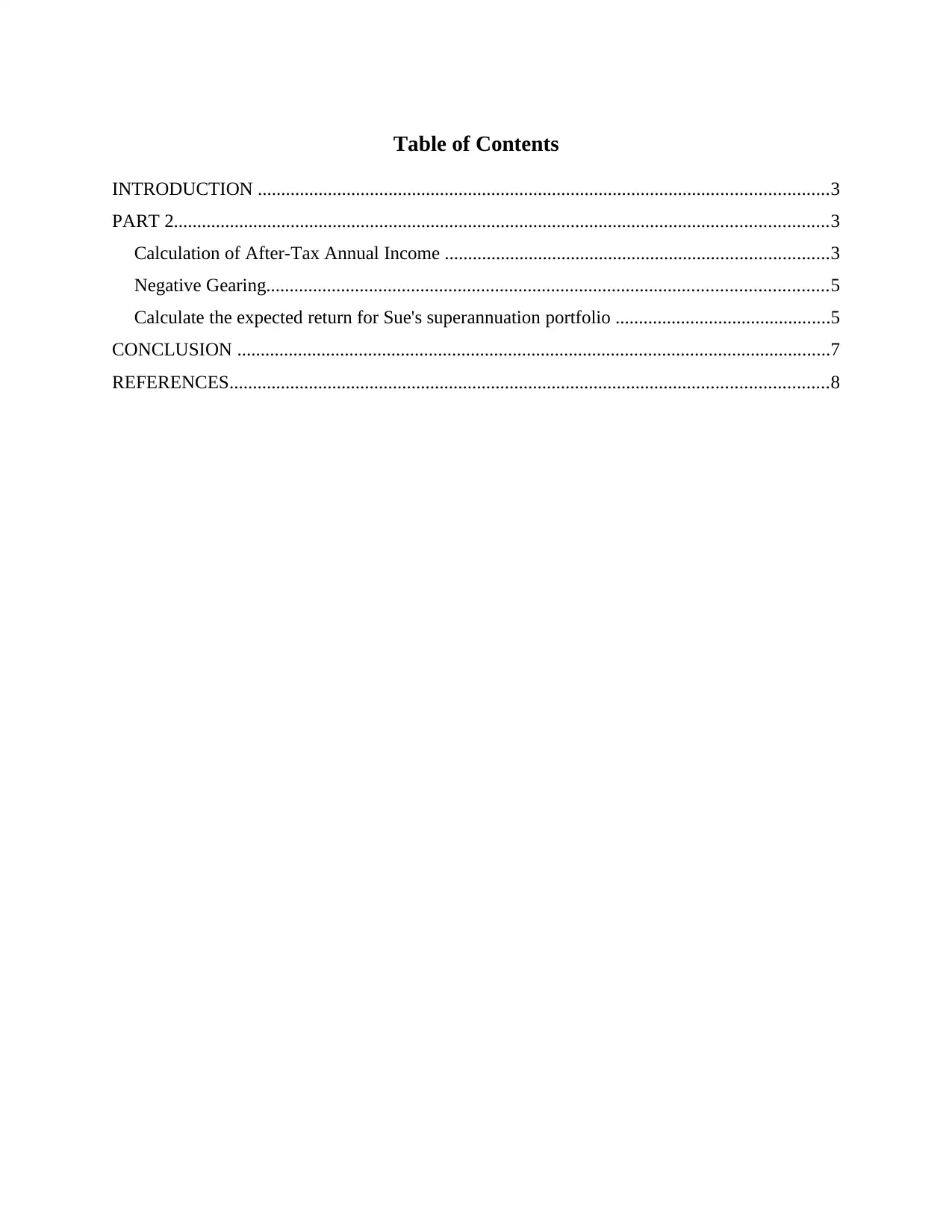
Table of Contents
INTRODUCTION ..........................................................................................................................3
PART 2............................................................................................................................................3
Calculation of After-Tax Annual Income ..................................................................................3
Negative Gearing........................................................................................................................5
Calculate the expected return for Sue's superannuation portfolio ..............................................5
CONCLUSION ...............................................................................................................................7
REFERENCES................................................................................................................................8
INTRODUCTION ..........................................................................................................................3
PART 2............................................................................................................................................3
Calculation of After-Tax Annual Income ..................................................................................3
Negative Gearing........................................................................................................................5
Calculate the expected return for Sue's superannuation portfolio ..............................................5
CONCLUSION ...............................................................................................................................7
REFERENCES................................................................................................................................8
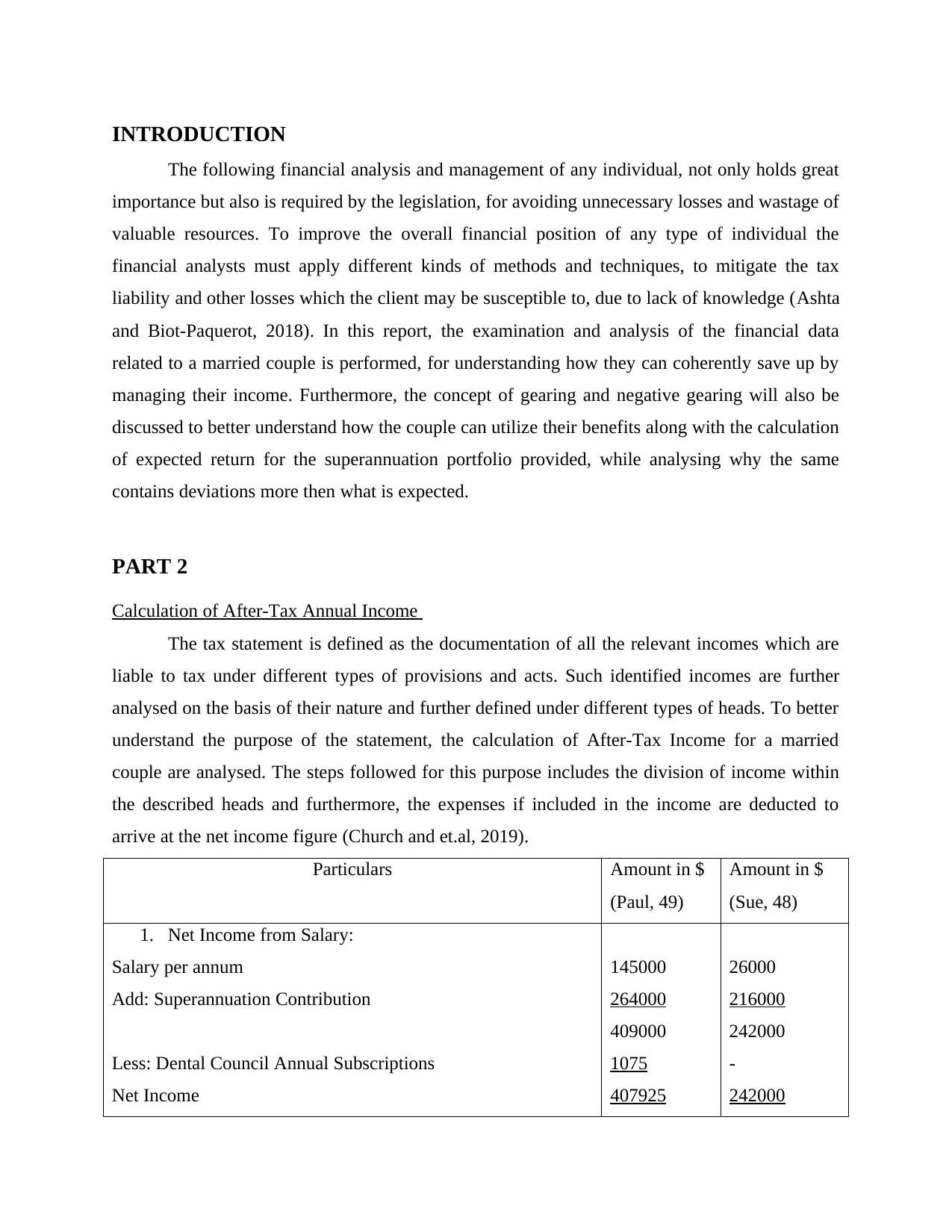
INTRODUCTION
The following financial analysis and management of any individual, not only holds great
importance but also is required by the legislation, for avoiding unnecessary losses and wastage of
valuable resources. To improve the overall financial position of any type of individual the
financial analysts must apply different kinds of methods and techniques, to mitigate the tax
liability and other losses which the client may be susceptible to, due to lack of knowledge (Ashta
and Biot‐Paquerot, 2018). In this report, the examination and analysis of the financial data
related to a married couple is performed, for understanding how they can coherently save up by
managing their income. Furthermore, the concept of gearing and negative gearing will also be
discussed to better understand how the couple can utilize their benefits along with the calculation
of expected return for the superannuation portfolio provided, while analysing why the same
contains deviations more then what is expected.
PART 2
Calculation of After-Tax Annual Income
The tax statement is defined as the documentation of all the relevant incomes which are
liable to tax under different types of provisions and acts. Such identified incomes are further
analysed on the basis of their nature and further defined under different types of heads. To better
understand the purpose of the statement, the calculation of After-Tax Income for a married
couple are analysed. The steps followed for this purpose includes the division of income within
the described heads and furthermore, the expenses if included in the income are deducted to
arrive at the net income figure (Church and et.al, 2019).
Particulars Amount in $
(Paul, 49)
Amount in $
(Sue, 48)
1. Net Income from Salary:
Salary per annum
Add: Superannuation Contribution
Less: Dental Council Annual Subscriptions
Net Income
145000
264000
409000
1075
407925
26000
216000
242000
-
242000
The following financial analysis and management of any individual, not only holds great
importance but also is required by the legislation, for avoiding unnecessary losses and wastage of
valuable resources. To improve the overall financial position of any type of individual the
financial analysts must apply different kinds of methods and techniques, to mitigate the tax
liability and other losses which the client may be susceptible to, due to lack of knowledge (Ashta
and Biot‐Paquerot, 2018). In this report, the examination and analysis of the financial data
related to a married couple is performed, for understanding how they can coherently save up by
managing their income. Furthermore, the concept of gearing and negative gearing will also be
discussed to better understand how the couple can utilize their benefits along with the calculation
of expected return for the superannuation portfolio provided, while analysing why the same
contains deviations more then what is expected.
PART 2
Calculation of After-Tax Annual Income
The tax statement is defined as the documentation of all the relevant incomes which are
liable to tax under different types of provisions and acts. Such identified incomes are further
analysed on the basis of their nature and further defined under different types of heads. To better
understand the purpose of the statement, the calculation of After-Tax Income for a married
couple are analysed. The steps followed for this purpose includes the division of income within
the described heads and furthermore, the expenses if included in the income are deducted to
arrive at the net income figure (Church and et.al, 2019).
Particulars Amount in $
(Paul, 49)
Amount in $
(Sue, 48)
1. Net Income from Salary:
Salary per annum
Add: Superannuation Contribution
Less: Dental Council Annual Subscriptions
Net Income
145000
264000
409000
1075
407925
26000
216000
242000
-
242000
⊘ This is a preview!⊘
Do you want full access?
Subscribe today to unlock all pages.

Trusted by 1+ million students worldwide
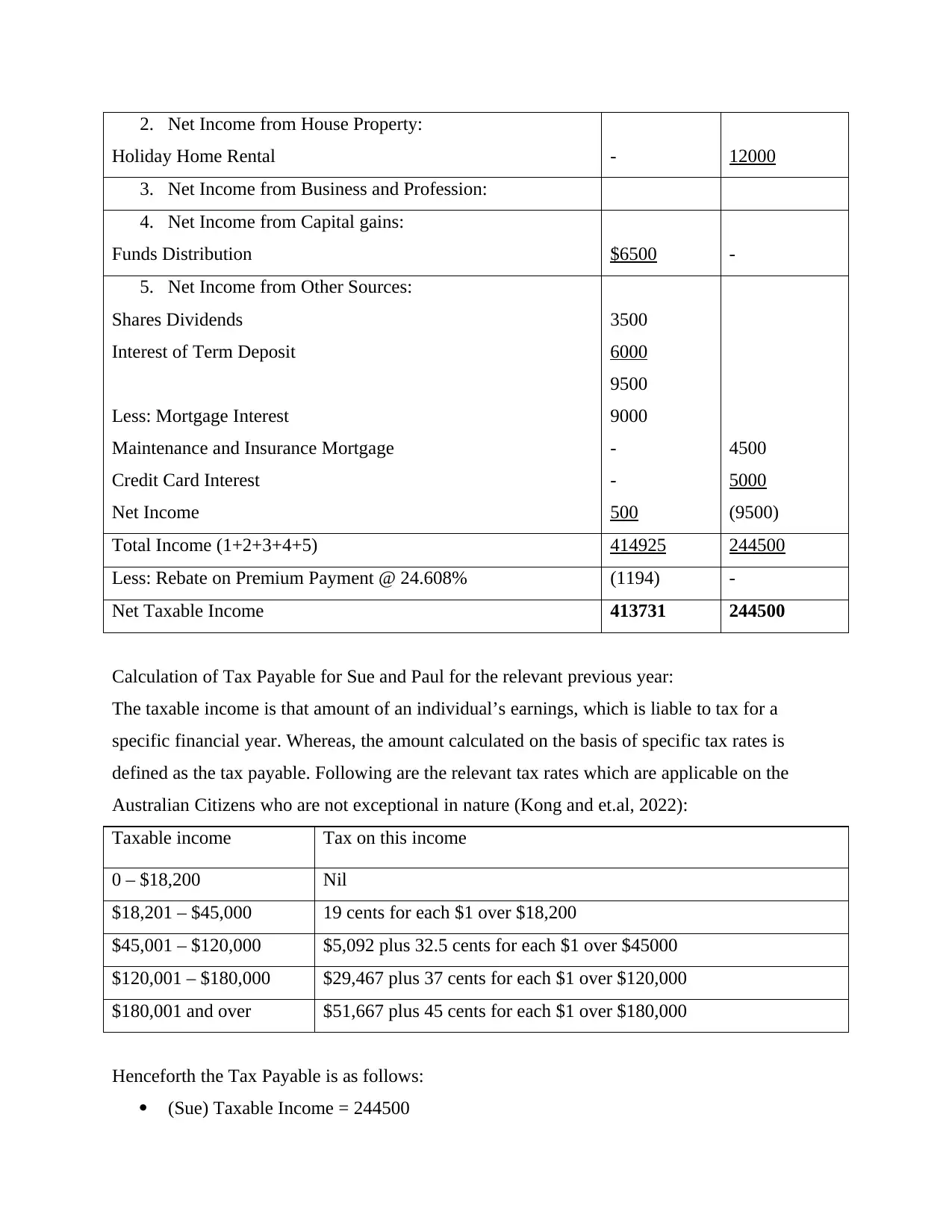
2. Net Income from House Property:
Holiday Home Rental - 12000
3. Net Income from Business and Profession:
4. Net Income from Capital gains:
Funds Distribution $6500 -
5. Net Income from Other Sources:
Shares Dividends
Interest of Term Deposit
Less: Mortgage Interest
Maintenance and Insurance Mortgage
Credit Card Interest
Net Income
3500
6000
9500
9000
-
-
500
4500
5000
(9500)
Total Income (1+2+3+4+5) 414925 244500
Less: Rebate on Premium Payment @ 24.608% (1194) -
Net Taxable Income 413731 244500
Calculation of Tax Payable for Sue and Paul for the relevant previous year:
The taxable income is that amount of an individual’s earnings, which is liable to tax for a
specific financial year. Whereas, the amount calculated on the basis of specific tax rates is
defined as the tax payable. Following are the relevant tax rates which are applicable on the
Australian Citizens who are not exceptional in nature (Kong and et.al, 2022):
Taxable income Tax on this income
0 – $18,200 Nil
$18,201 – $45,000 19 cents for each $1 over $18,200
$45,001 – $120,000 $5,092 plus 32.5 cents for each $1 over $45000
$120,001 – $180,000 $29,467 plus 37 cents for each $1 over $120,000
$180,001 and over $51,667 plus 45 cents for each $1 over $180,000
Henceforth the Tax Payable is as follows:
(Sue) Taxable Income = 244500
Holiday Home Rental - 12000
3. Net Income from Business and Profession:
4. Net Income from Capital gains:
Funds Distribution $6500 -
5. Net Income from Other Sources:
Shares Dividends
Interest of Term Deposit
Less: Mortgage Interest
Maintenance and Insurance Mortgage
Credit Card Interest
Net Income
3500
6000
9500
9000
-
-
500
4500
5000
(9500)
Total Income (1+2+3+4+5) 414925 244500
Less: Rebate on Premium Payment @ 24.608% (1194) -
Net Taxable Income 413731 244500
Calculation of Tax Payable for Sue and Paul for the relevant previous year:
The taxable income is that amount of an individual’s earnings, which is liable to tax for a
specific financial year. Whereas, the amount calculated on the basis of specific tax rates is
defined as the tax payable. Following are the relevant tax rates which are applicable on the
Australian Citizens who are not exceptional in nature (Kong and et.al, 2022):
Taxable income Tax on this income
0 – $18,200 Nil
$18,201 – $45,000 19 cents for each $1 over $18,200
$45,001 – $120,000 $5,092 plus 32.5 cents for each $1 over $45000
$120,001 – $180,000 $29,467 plus 37 cents for each $1 over $120,000
$180,001 and over $51,667 plus 45 cents for each $1 over $180,000
Henceforth the Tax Payable is as follows:
(Sue) Taxable Income = 244500
Paraphrase This Document
Need a fresh take? Get an instant paraphrase of this document with our AI Paraphraser
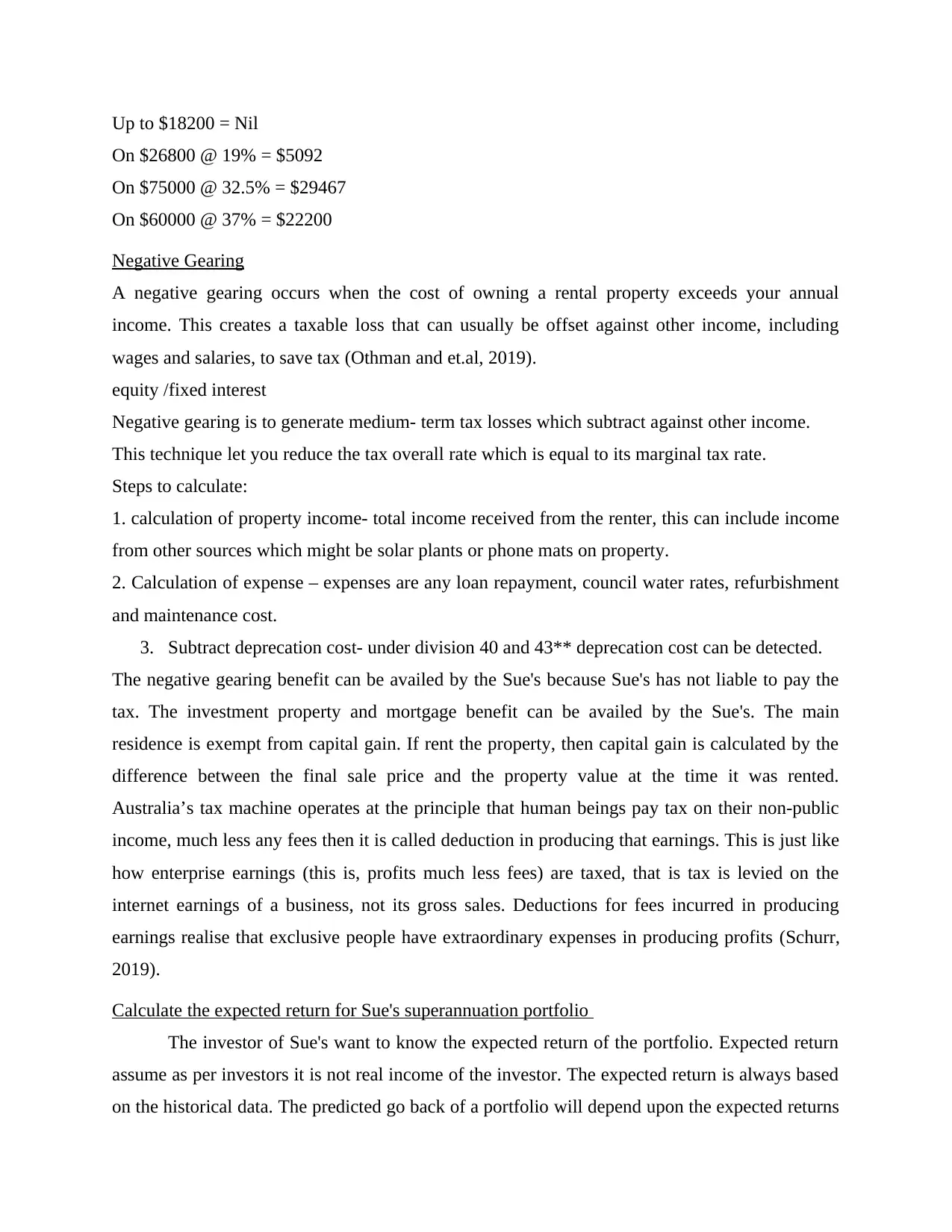
Up to $18200 = Nil
On $26800 @ 19% = $5092
On $75000 @ 32.5% = $29467
On $60000 @ 37% = $22200
Negative Gearing
A negative gearing occurs when the cost of owning a rental property exceeds your annual
income. This creates a taxable loss that can usually be offset against other income, including
wages and salaries, to save tax (Othman and et.al, 2019).
equity /fixed interest
Negative gearing is to generate medium- term tax losses which subtract against other income.
This technique let you reduce the tax overall rate which is equal to its marginal tax rate.
Steps to calculate:
1. calculation of property income- total income received from the renter, this can include income
from other sources which might be solar plants or phone mats on property.
2. Calculation of expense – expenses are any loan repayment, council water rates, refurbishment
and maintenance cost.
3. Subtract deprecation cost- under division 40 and 43** deprecation cost can be detected.
The negative gearing benefit can be availed by the Sue's because Sue's has not liable to pay the
tax. The investment property and mortgage benefit can be availed by the Sue's. The main
residence is exempt from capital gain. If rent the property, then capital gain is calculated by the
difference between the final sale price and the property value at the time it was rented.
Australia’s tax machine operates at the principle that human beings pay tax on their non-public
income, much less any fees then it is called deduction in producing that earnings. This is just like
how enterprise earnings (this is, profits much less fees) are taxed, that is tax is levied on the
internet earnings of a business, not its gross sales. Deductions for fees incurred in producing
earnings realise that exclusive people have extraordinary expenses in producing profits (Schurr,
2019).
Calculate the expected return for Sue's superannuation portfolio
The investor of Sue's want to know the expected return of the portfolio. Expected return
assume as per investors it is not real income of the investor. The expected return is always based
on the historical data. The predicted go back of a portfolio will depend upon the expected returns
On $26800 @ 19% = $5092
On $75000 @ 32.5% = $29467
On $60000 @ 37% = $22200
Negative Gearing
A negative gearing occurs when the cost of owning a rental property exceeds your annual
income. This creates a taxable loss that can usually be offset against other income, including
wages and salaries, to save tax (Othman and et.al, 2019).
equity /fixed interest
Negative gearing is to generate medium- term tax losses which subtract against other income.
This technique let you reduce the tax overall rate which is equal to its marginal tax rate.
Steps to calculate:
1. calculation of property income- total income received from the renter, this can include income
from other sources which might be solar plants or phone mats on property.
2. Calculation of expense – expenses are any loan repayment, council water rates, refurbishment
and maintenance cost.
3. Subtract deprecation cost- under division 40 and 43** deprecation cost can be detected.
The negative gearing benefit can be availed by the Sue's because Sue's has not liable to pay the
tax. The investment property and mortgage benefit can be availed by the Sue's. The main
residence is exempt from capital gain. If rent the property, then capital gain is calculated by the
difference between the final sale price and the property value at the time it was rented.
Australia’s tax machine operates at the principle that human beings pay tax on their non-public
income, much less any fees then it is called deduction in producing that earnings. This is just like
how enterprise earnings (this is, profits much less fees) are taxed, that is tax is levied on the
internet earnings of a business, not its gross sales. Deductions for fees incurred in producing
earnings realise that exclusive people have extraordinary expenses in producing profits (Schurr,
2019).
Calculate the expected return for Sue's superannuation portfolio
The investor of Sue's want to know the expected return of the portfolio. Expected return
assume as per investors it is not real income of the investor. The expected return is always based
on the historical data. The predicted go back of a portfolio will depend upon the expected returns
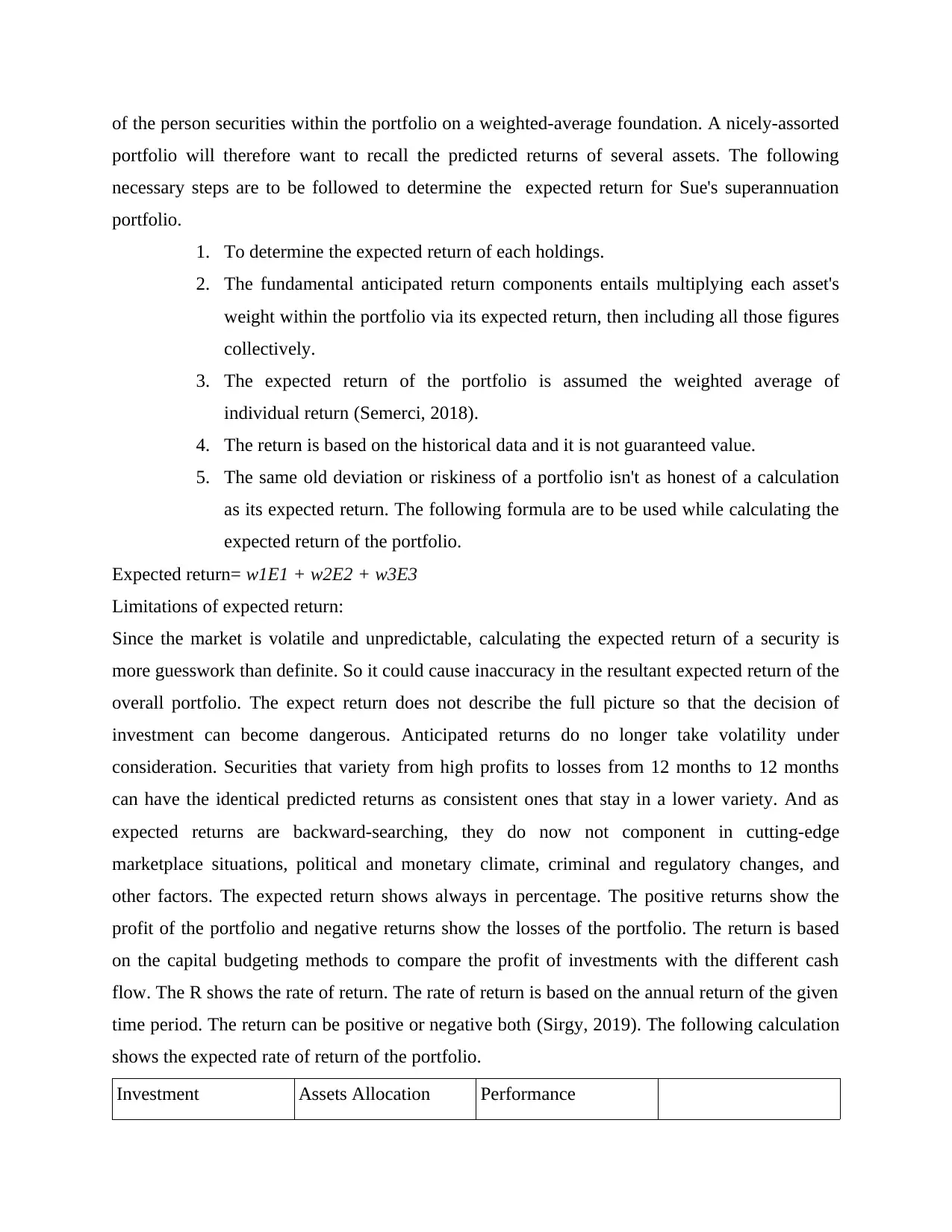
of the person securities within the portfolio on a weighted-average foundation. A nicely-assorted
portfolio will therefore want to recall the predicted returns of several assets. The following
necessary steps are to be followed to determine the expected return for Sue's superannuation
portfolio.
1. To determine the expected return of each holdings.
2. The fundamental anticipated return components entails multiplying each asset's
weight within the portfolio via its expected return, then including all those figures
collectively.
3. The expected return of the portfolio is assumed the weighted average of
individual return (Semerci, 2018).
4. The return is based on the historical data and it is not guaranteed value.
5. The same old deviation or riskiness of a portfolio isn't as honest of a calculation
as its expected return. The following formula are to be used while calculating the
expected return of the portfolio.
Expected return= w1E1 + w2E2 + w3E3
Limitations of expected return:
Since the market is volatile and unpredictable, calculating the expected return of a security is
more guesswork than definite. So it could cause inaccuracy in the resultant expected return of the
overall portfolio. The expect return does not describe the full picture so that the decision of
investment can become dangerous. Anticipated returns do no longer take volatility under
consideration. Securities that variety from high profits to losses from 12 months to 12 months
can have the identical predicted returns as consistent ones that stay in a lower variety. And as
expected returns are backward-searching, they do now not component in cutting-edge
marketplace situations, political and monetary climate, criminal and regulatory changes, and
other factors. The expected return shows always in percentage. The positive returns show the
profit of the portfolio and negative returns show the losses of the portfolio. The return is based
on the capital budgeting methods to compare the profit of investments with the different cash
flow. The R shows the rate of return. The rate of return is based on the annual return of the given
time period. The return can be positive or negative both (Sirgy, 2019). The following calculation
shows the expected rate of return of the portfolio.
Investment Assets Allocation Performance
portfolio will therefore want to recall the predicted returns of several assets. The following
necessary steps are to be followed to determine the expected return for Sue's superannuation
portfolio.
1. To determine the expected return of each holdings.
2. The fundamental anticipated return components entails multiplying each asset's
weight within the portfolio via its expected return, then including all those figures
collectively.
3. The expected return of the portfolio is assumed the weighted average of
individual return (Semerci, 2018).
4. The return is based on the historical data and it is not guaranteed value.
5. The same old deviation or riskiness of a portfolio isn't as honest of a calculation
as its expected return. The following formula are to be used while calculating the
expected return of the portfolio.
Expected return= w1E1 + w2E2 + w3E3
Limitations of expected return:
Since the market is volatile and unpredictable, calculating the expected return of a security is
more guesswork than definite. So it could cause inaccuracy in the resultant expected return of the
overall portfolio. The expect return does not describe the full picture so that the decision of
investment can become dangerous. Anticipated returns do no longer take volatility under
consideration. Securities that variety from high profits to losses from 12 months to 12 months
can have the identical predicted returns as consistent ones that stay in a lower variety. And as
expected returns are backward-searching, they do now not component in cutting-edge
marketplace situations, political and monetary climate, criminal and regulatory changes, and
other factors. The expected return shows always in percentage. The positive returns show the
profit of the portfolio and negative returns show the losses of the portfolio. The return is based
on the capital budgeting methods to compare the profit of investments with the different cash
flow. The R shows the rate of return. The rate of return is based on the annual return of the given
time period. The return can be positive or negative both (Sirgy, 2019). The following calculation
shows the expected rate of return of the portfolio.
Investment Assets Allocation Performance
⊘ This is a preview!⊘
Do you want full access?
Subscribe today to unlock all pages.

Trusted by 1+ million students worldwide
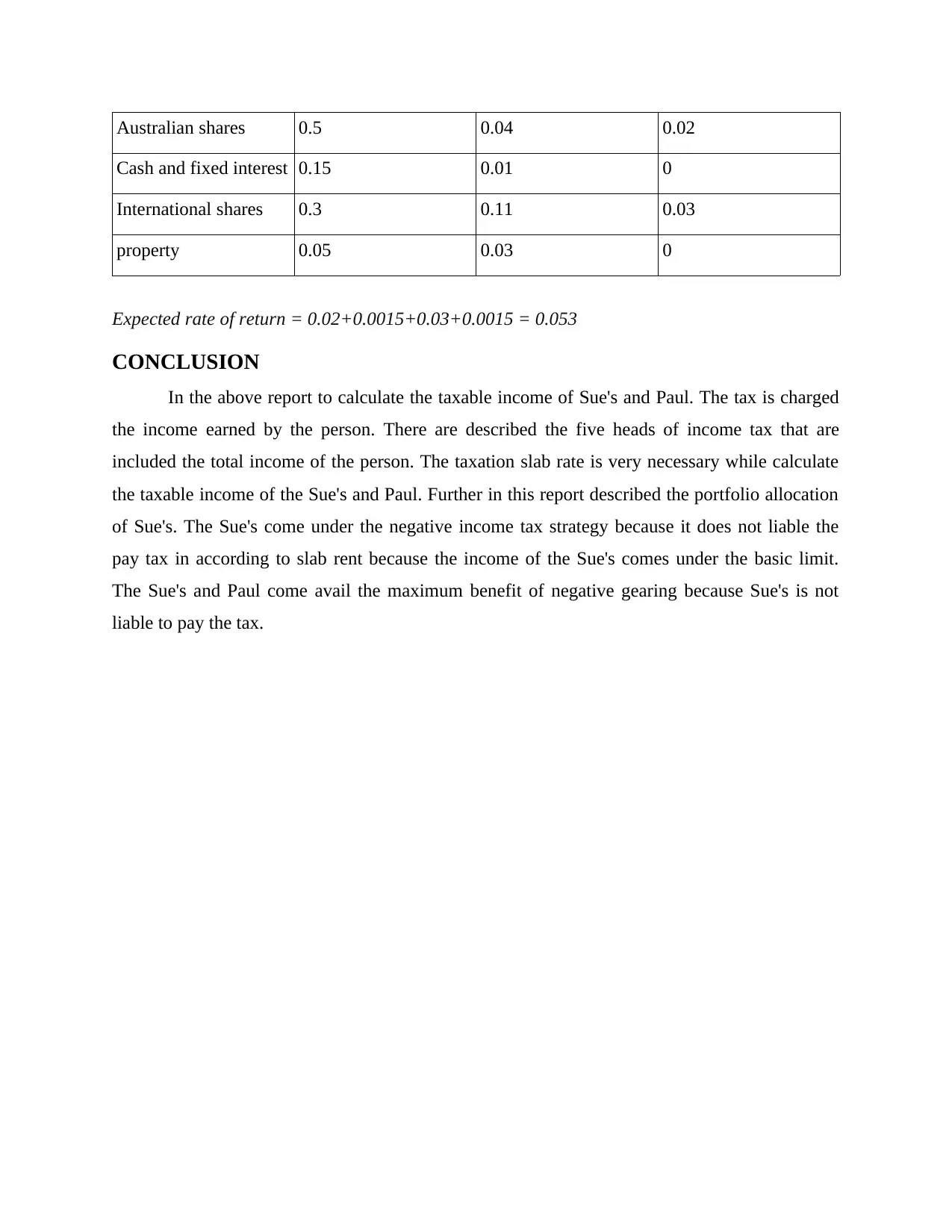
Australian shares 0.5 0.04 0.02
Cash and fixed interest 0.15 0.01 0
International shares 0.3 0.11 0.03
property 0.05 0.03 0
Expected rate of return = 0.02+0.0015+0.03+0.0015 = 0.053
CONCLUSION
In the above report to calculate the taxable income of Sue's and Paul. The tax is charged
the income earned by the person. There are described the five heads of income tax that are
included the total income of the person. The taxation slab rate is very necessary while calculate
the taxable income of the Sue's and Paul. Further in this report described the portfolio allocation
of Sue's. The Sue's come under the negative income tax strategy because it does not liable the
pay tax in according to slab rent because the income of the Sue's comes under the basic limit.
The Sue's and Paul come avail the maximum benefit of negative gearing because Sue's is not
liable to pay the tax.
Cash and fixed interest 0.15 0.01 0
International shares 0.3 0.11 0.03
property 0.05 0.03 0
Expected rate of return = 0.02+0.0015+0.03+0.0015 = 0.053
CONCLUSION
In the above report to calculate the taxable income of Sue's and Paul. The tax is charged
the income earned by the person. There are described the five heads of income tax that are
included the total income of the person. The taxation slab rate is very necessary while calculate
the taxable income of the Sue's and Paul. Further in this report described the portfolio allocation
of Sue's. The Sue's come under the negative income tax strategy because it does not liable the
pay tax in according to slab rent because the income of the Sue's comes under the basic limit.
The Sue's and Paul come avail the maximum benefit of negative gearing because Sue's is not
liable to pay the tax.
Paraphrase This Document
Need a fresh take? Get an instant paraphrase of this document with our AI Paraphraser
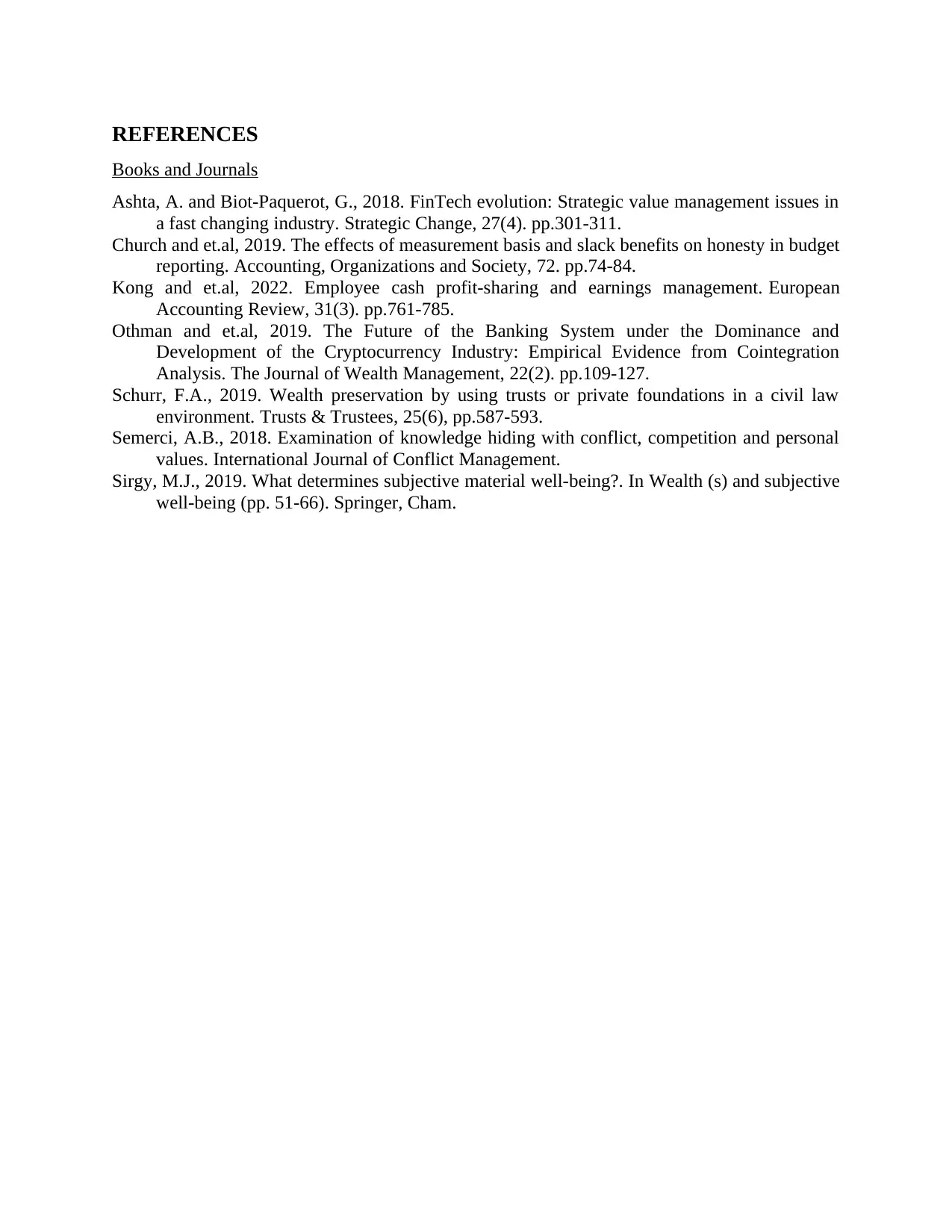
REFERENCES
Books and Journals
Ashta, A. and Biot‐Paquerot, G., 2018. FinTech evolution: Strategic value management issues in
a fast changing industry. Strategic Change, 27(4). pp.301-311.
Church and et.al, 2019. The effects of measurement basis and slack benefits on honesty in budget
reporting. Accounting, Organizations and Society, 72. pp.74-84.
Kong and et.al, 2022. Employee cash profit-sharing and earnings management. European
Accounting Review, 31(3). pp.761-785.
Othman and et.al, 2019. The Future of the Banking System under the Dominance and
Development of the Cryptocurrency Industry: Empirical Evidence from Cointegration
Analysis. The Journal of Wealth Management, 22(2). pp.109-127.
Schurr, F.A., 2019. Wealth preservation by using trusts or private foundations in a civil law
environment. Trusts & Trustees, 25(6), pp.587-593.
Semerci, A.B., 2018. Examination of knowledge hiding with conflict, competition and personal
values. International Journal of Conflict Management.
Sirgy, M.J., 2019. What determines subjective material well-being?. In Wealth (s) and subjective
well-being (pp. 51-66). Springer, Cham.
Books and Journals
Ashta, A. and Biot‐Paquerot, G., 2018. FinTech evolution: Strategic value management issues in
a fast changing industry. Strategic Change, 27(4). pp.301-311.
Church and et.al, 2019. The effects of measurement basis and slack benefits on honesty in budget
reporting. Accounting, Organizations and Society, 72. pp.74-84.
Kong and et.al, 2022. Employee cash profit-sharing and earnings management. European
Accounting Review, 31(3). pp.761-785.
Othman and et.al, 2019. The Future of the Banking System under the Dominance and
Development of the Cryptocurrency Industry: Empirical Evidence from Cointegration
Analysis. The Journal of Wealth Management, 22(2). pp.109-127.
Schurr, F.A., 2019. Wealth preservation by using trusts or private foundations in a civil law
environment. Trusts & Trustees, 25(6), pp.587-593.
Semerci, A.B., 2018. Examination of knowledge hiding with conflict, competition and personal
values. International Journal of Conflict Management.
Sirgy, M.J., 2019. What determines subjective material well-being?. In Wealth (s) and subjective
well-being (pp. 51-66). Springer, Cham.
1 out of 8
Related Documents
Your All-in-One AI-Powered Toolkit for Academic Success.
+13062052269
info@desklib.com
Available 24*7 on WhatsApp / Email
![[object Object]](/_next/static/media/star-bottom.7253800d.svg)
Unlock your academic potential
Copyright © 2020–2025 A2Z Services. All Rights Reserved. Developed and managed by ZUCOL.





